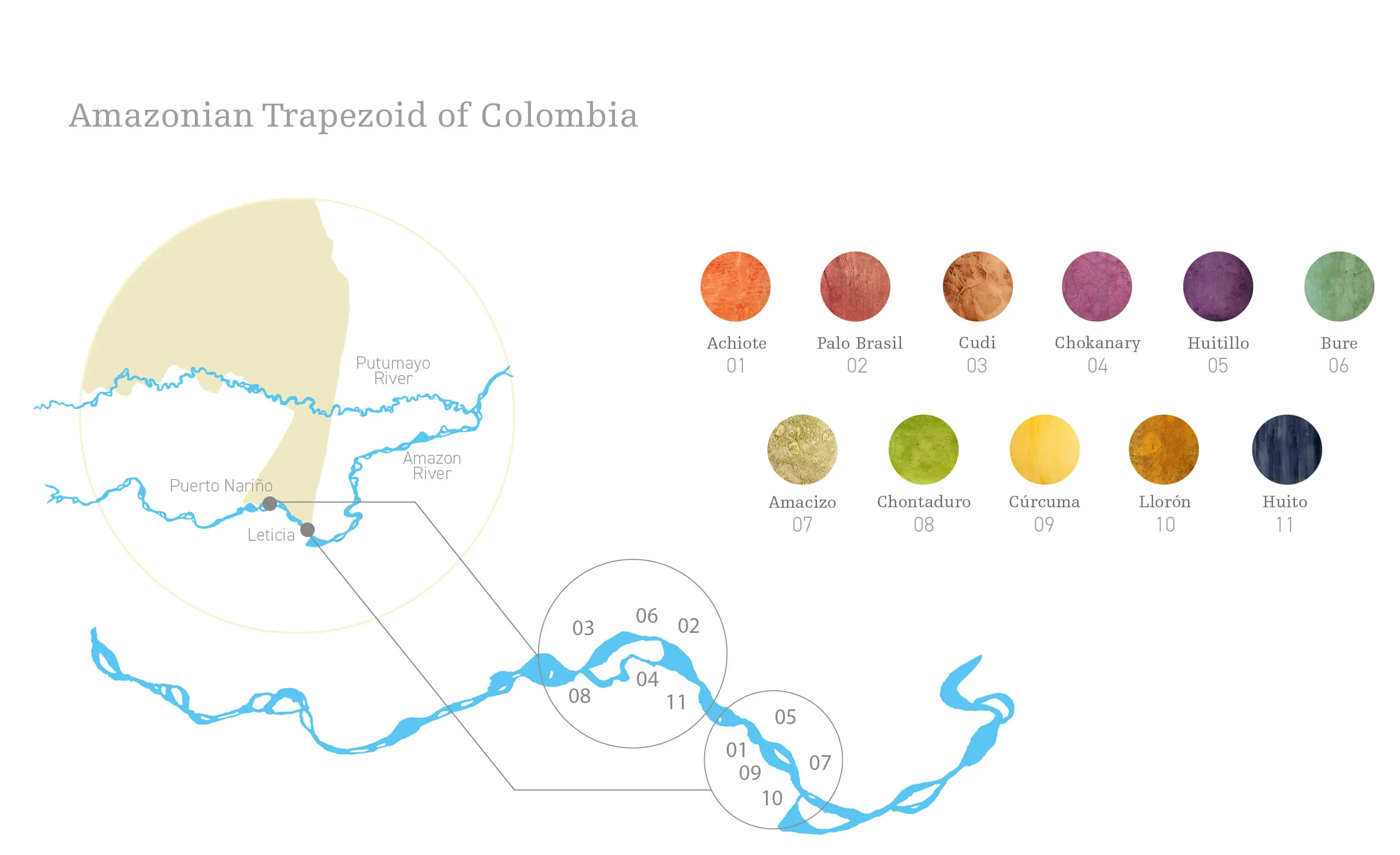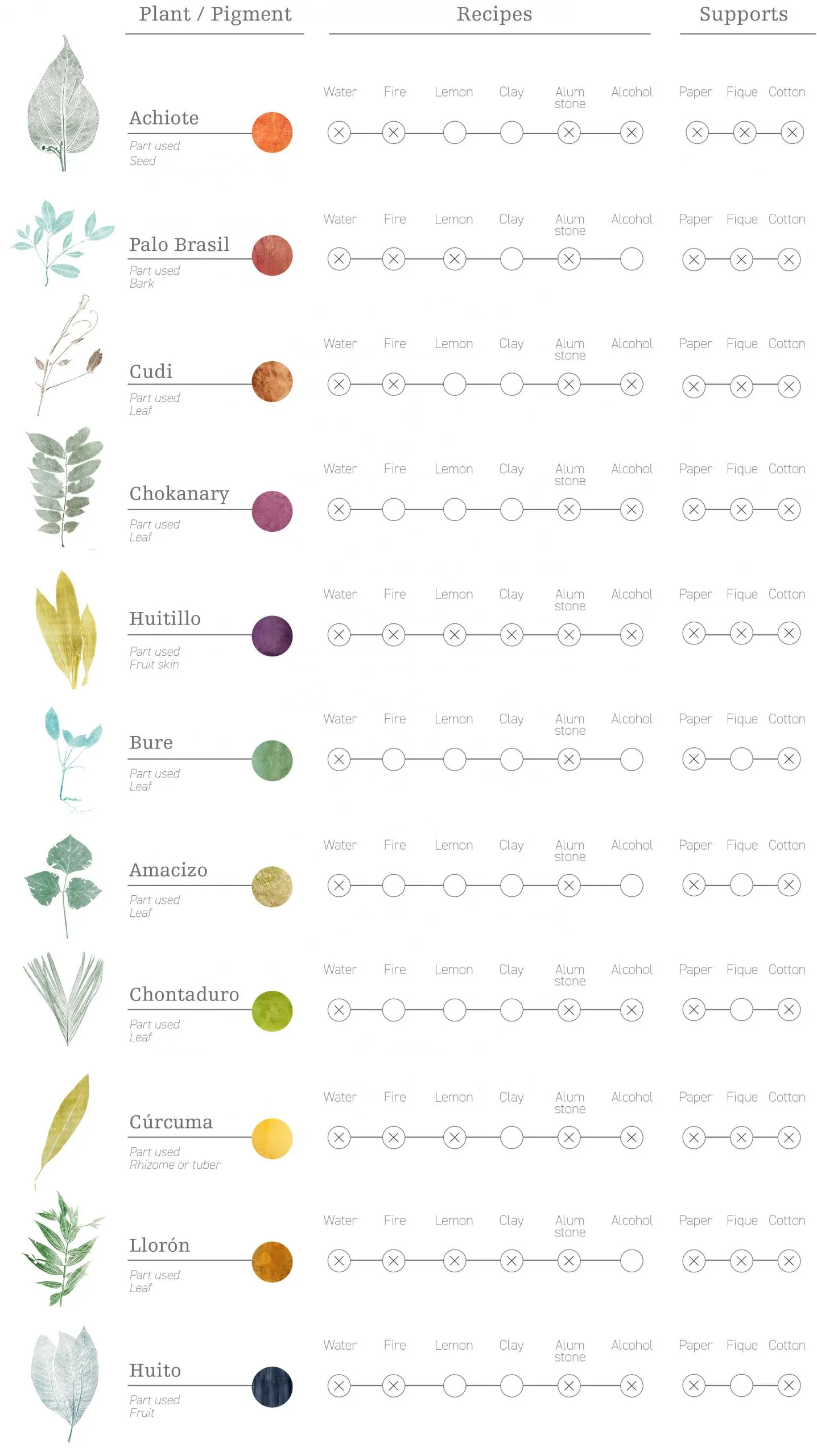Cart
El carrito esta vacio
Subtotal
$0
Total
$0
Color Amazonia
Introduction
Workshop de color instalado junto a la casa de una familia Huitoto cerca a Leticia, Colombia, 2007 – 2012.
In recent years, together with a group of friends, we have roamed the Colombian Amazon in search of color.
Guided by the ancestral knowledge of the Huitoto and Tikuna communities, we identified eleven botanical species and the alchemical processes that make it possible to use their pigments in an artisanal way on natural fibers such as fique, cotton, and paper.
Near the city of Leticia, we set up a rustic workshop to explore and understand these manual processes in a close and direct relationship with the environment: an encounter between the essence of human nature, which knows how to transform, and botanical nature, which offers surprising possibilities.
Color Amazonia is the memory of this elemental search, where color is a pretext to exalt the immense value of this disappearing forest.
Susana Mejía
Color extraction process

Leaves, fruits and tubers ready to be converted into pigments.
Extraction and dyeing
The extraction of color from the eleven plant species that were experimented with involves similar processes: it is necessary to macerate or grate the part of the plant that produces the color —leaf, seed, bark, fruit, fruit peel, or rhizome, depending on the case— and then add water. Afterwards, depending on the plant, various processes may be required, such as applying heat or using other natural elements to fix or transform the color. Among these:
Water:
dissolves the color.
Fire:
extracts the color through boiling.
Lemon:
natural catalyst that lightens colors.
White clay:
color diffuser, used to create pastel tones.
Alum stone:
mordant, sets the color.

Process of dyeing natural fibers with pigment
The rite of color
For Indigenous peoples, color is associated with ritual. In this project, the ritual is organized and documented. The ceremony is crafted and conceived so that, together with images and sounds, it becomes a work of art that highlights the importance of the process and of collective labor.
This practice uncovers color palettes that did not previously exist. Within them, the simple naming of a color—such as red or green—is not possible. Colors, their variations, and subtle shades emerge through process and experimentation, through trial and error, through spontaneous pouring and slow drying, through music and through journeying. In this way, color becomes a product close to science and, at the same time, an act of art.
The work presented in this book reconsiders the inscription of nature onto surfaces and the role of chance in the creative process. Painting—and more precisely, color—takes over the space; but without the sounds of the jungle, the plants, the herbariums, the documents, the monotypes, the archives, and the moving image, it would lose its magic. The power of this work—worth emphasizing—lies in embracing the creation of color as a ritual process.
Here, wonder is produced by collective work. More than a finished piece, we are witnessing an archival or laboratory work that moves with equal interest from abstraction to expressionism, from anthropology to botany. Each color is a discovery, an opportunity to understand the geographic place. This work synchronizes art with community work and botanical knowledge, thereby proposing an artistic ecology. The color of the jungle is thus recontextualized and re-signified.
Color workshop in the Amazon. Leticia, Colombia, 2011
Mixture of organic pigments on paper
Wallpapers with natural pigments drying. Leticia, Colombia, 2007–2012.
Wallpapers with natural pigments drying. Leticia, Colombia, 2007–2012.
Fique dyed with organic pigments during drying. Leticia, Colombia, 2007–2012.
Fique dyed with organic pigments during drying. Leticia, Colombia, 2007–2012.
Preparation of fique and cotton for dyeing
Sounds
Fique dyed with natural pigments
Acknowledgments
A very special thanks to Kasia and Tomasa; to Verónica, Kathy, Jaime, Daniel, Arturo, Mónica, Celcida, and the rest of the Huitoto family at kilometer 11 of Leticia.
To the colleagues, advisors, and friends who offered guidance and shared their knowledge:
Jairo Upegui (journeys, herbarium, ideas, and companionship)
Eduardo Arango (journeys and ideas)
Jorge Montoya (journeys, photography, and gardening)
Viviana Palacio (ideas and reflections)
Esteban Uribe (video)
Nicolás Wills (music and video sound)
Carlos Tobón (photography)
Ángela María Restrepo (monotypes, ideas, and companionship)
Alberto Sierra (advisor and companion)
Julián Posada (advisor and companion)
Álvaro Cogollo (botanical consulting)
Juan Álvaro Echeverri (information in Leticia)
Johana Bojanini (illustrations)
Elvis Peña, in Leticia, Amazonas (Amazon companionship)
Marta Lopera (weaver)
José Reyes, in Leticia, Amazonas (guide and driver)
Juan Luis Mejía
Héctor Abad Faciolince
José Ignacio Roca
To my studio team:
Daniel Montoya
Margarita Rada
Elisa Echavarría
Lina Rada